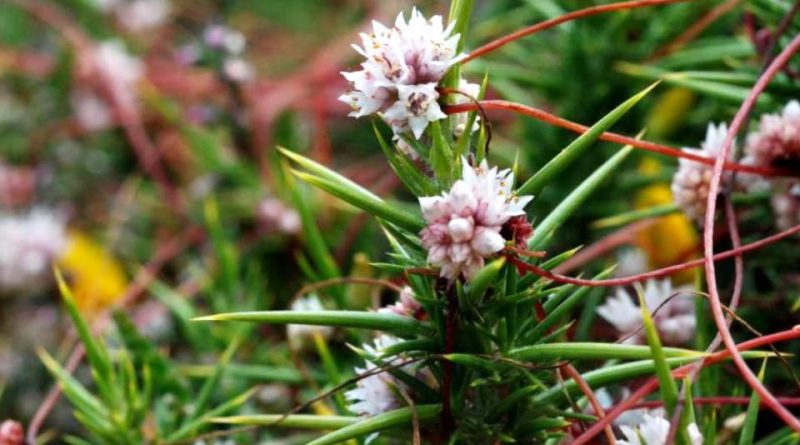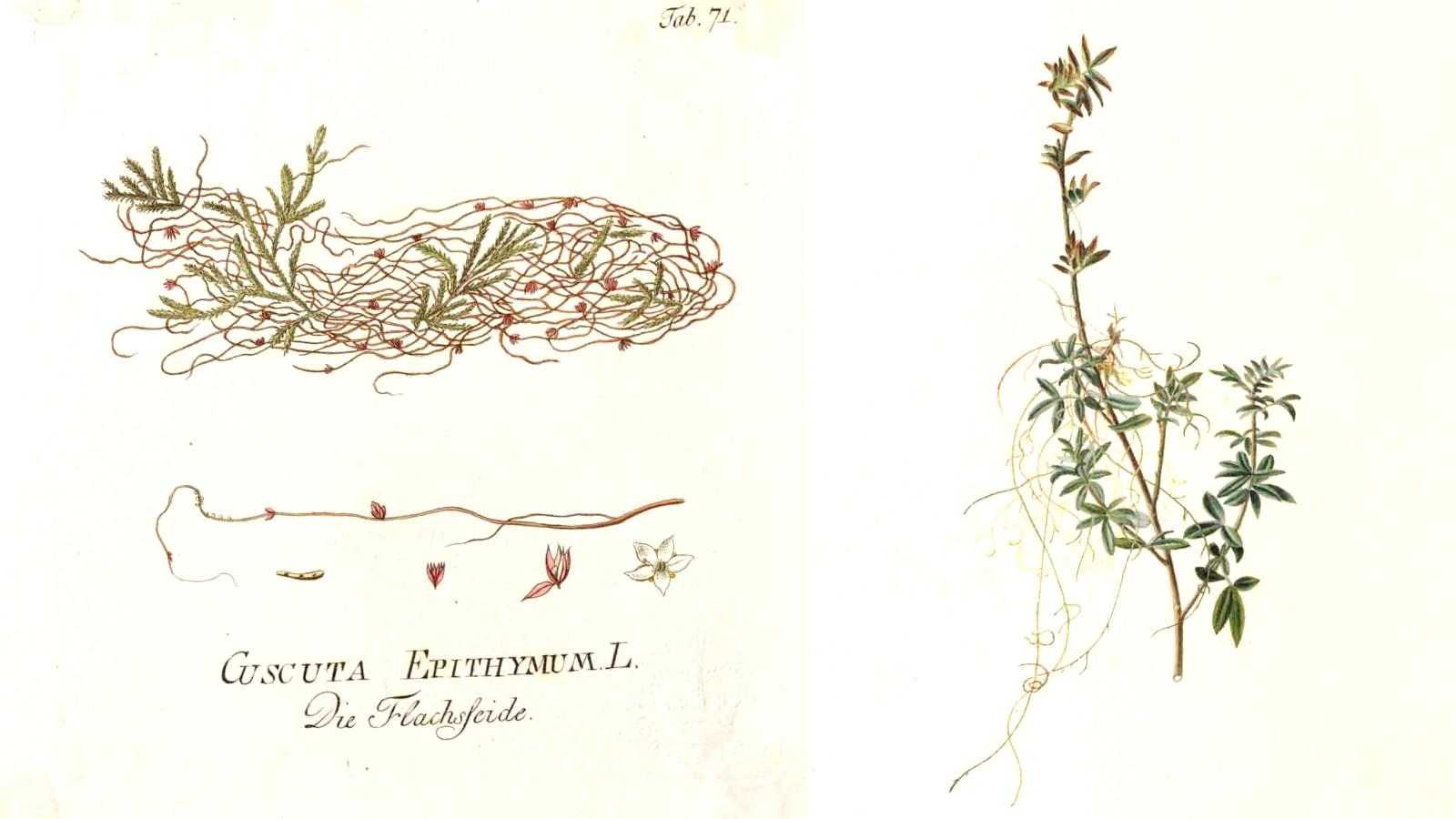Cuscuta epithymum
Cuscuta epithymum
The Alfalfa dodder or clover dodder, common dodder, (Cuscuta epithymum L.) is a parasitic herbaceous species belonging to the Convolvulaceae family.
Systematics –
From the systematic point of view it belongs to the Eukaryota Domain, Kingdom Plantae, Subarign Tracheobionta, Superdivisione Spermatophyta, Magnoliophyta Division, Magnoliopsida Class, Sottoclasse Asteridae, Order Solanales, Family Convolvulaceae, Tribe Cuscutae and therefore to the Genus Cuscuta and to the Species C. epithymum.
Basionimo is the term:
– Cuscuta europaea subsp. epithymum L .;
The terms are synonymous:
– Cuscuta acutiflora Rota;
– Cuscuta alba C. Presl
– Cuscuta campanulata Stokes;
– Cuscuta coriariae Sennen & Pau;
– Cuscuta epithymiphyta St.-Lég .;
– Cuscuta europaea var. epithymum L .;
– Cuscuta hygrogenes Ghent .;
– Cuscuta muelleri Strail;
– Cuscuta subulata Tineo
– Cuscuta trifolii Bab .;
– Cuscuta ulicis Godr .;
– Lepimenes epithymum (L.) Raf.
Within this species, the following subspecies are recognized:
– Cuscuta epithymum subsp. alba (J. Presl & C. Presl) Trab .;
– Cuscuta epithymum subsp. corsicana (Yunck.) Lambinon
– Cuscuta epithymum subsp. kotschyi (Des Moul.) Engelm .;
– Cuscuta epithymum subsp. macranthera (Heldr. & Sartoni) Engelm .;
– Cuscuta epithymum subsp. rubella (Engelm.) Trab .;
– Cuscuta epithymum subsp. scabrella (Engelm.) Yunck.
In Italy the following subspecies are present:
– Cuscuta epithymum subsp. corsicana (Yunck.) Lambinon;
– Cuscuta epithymum subsp. kotschyi (Des Moul.) Engelm ..
Etymology –
The term Cuscuta comes from the Arabic kúshuth.
The specific epithymum epithymum comes from the Greek ἐπί epí su, above and from Thymus thyme: which grows on thyme, the host of choice for these parasitic plants.
Geographic Distribution and Habitat –
Cuscuta epithymum is a plant native to Europe where it grows in most of the territory, including Great Britain, from Norway to Spain and from the east to the Caucasus and Central Asia.
This plant with Eurasian distribution is also present in Italy, in all regions.
Its habitat is in grassy places and along roads, where it prefers fields of legumes, between 0-1500 m, and lives as a parasite of other plants (being devoid of colorophyll) including herbaceous and woody or suffruticose species, on the genus Thymus , Lamiaceae and Fabaceae.
Description –
Cuscuta epithymum is an annual herbaceous plant.
The stems are thin and threadlike, yellow or reddish in color.
It is a parasitic plant, without leaves and without chlorophyll, so it attaches itself to the host plant with the austori, which are suckers that penetrate the stem of the host plant and enter the area where the sap circulates.
As soon as it has sprouted, the plant has a small root that soon disappears, the stem elongates and, as soon as it touches a possible host, it twists with two or three coils: immediately in the part in contact, the austors are formed which provide the plant with food for growth.
The flowers consist of a short peduncle and are inserted in dense subrotund glomeruli; the calyx is more or less fleshy, has a bell-shaped shape and is divided up to half into five lobes broadly oval and sharp at the apex; the corolla is a little longer than the calyx and is white-pink in color and terminated by five triangular-acute lobes facing outwards.
The flowering period is between July and October.
The fruit is a globular capsule depressed at the apex containing numerous seeds of one millimeter in diameter with a smooth surface and brown color.
Cultivation –
Cuscuta epithymum is a parasitic species devoid of leaves, roots or chlorophyll and therefore is totally dependent on its host. It is a climbing plant that must be grown near a host plant around which it will twist and which it will penetrate with suckers to obtain its nourishment. The flowers give off an extraordinarily sweet scent that is particularly pronounced towards the evening.
Customs and Traditions –
Cuscuta epithymum is a plant with pharmaceutical properties: cholagogue, carminative, sedative. The drug used is the whole plant.
It is therefore considered a precious herbal remedy even if little used that supports the liver, being used for problems affecting the liver and gallbladder.The whole plant is aperitif, carminative, cholagogue, slightly diuretic, hepatic, laxative and antiscorbutic. A decoction of stems is used in the treatment of urinary disorders, kidney, spleen and liver disorders, jaundice, sciatica and scurvy disorders. It also has a reputation as an anticancer agent and as a specific remedy for gout. Among the contraindications it is recommended not to use the plant for those suffering from hemorrhoids from the plant a homeopathic remedy is also produced.
Preparation Method –
All parts of the plant are used to prepare decoctions useful for the treatment of the remedies and diseases indicated above.
Guido Bissanti
Sources
– Acta Plantarum – Flora of the Italian Regions.
– Wikipedia, the free encyclopedia.
– Useful Tropical Plants Database.
– Conti F., Abbate G., Alessandrini A., Blasi C. (edited by), 2005. An annotated checklist of the Italian vascular flora, Palombi Editore.
– Pignatti S., 1982. Flora of Italy, Edagricole, Bologna.
– Treben M., 2000. Health from the Lord’s Pharmacy, Advice and experiences with medicinal herbs, Ennsthaler Editore.
Warning: Pharmaceutical applications and alimurgical uses are indicated for informational purposes only, they do not represent in any way a medical prescription; therefore no responsibility is taken for their use for curative, aesthetic or food purposes.


